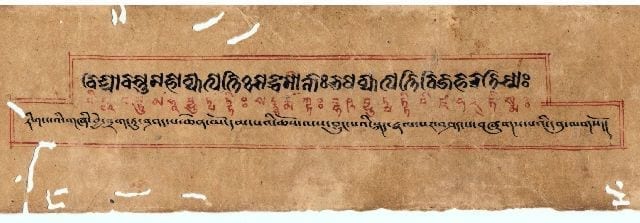Grammar: The Establishment of a Dharma Language
When Buddhism entered Tibet from India, it faced a linguistic challenge. How would one explain even the word “Buddha”? Many Dharma terms had no equivalents in the dialects spoken in the Himalayan regions. Therefore, the early 9th century King Thride Songtsen, better known as Sadnalegs (the youngest son of the emperor Tri Songdetsen gathered learned scholars at Samye Monastery. There he instructed them to compile a classical Tibetan language. The vocabulary employed needed to be sufficiently rich to translate the sophisticated Buddhist literature. These scholars created a systematic method relying on loan translations and concepts. At the same time, they created grammatical manuals and dictionaries.
The “Two-volume Word Combination or Lexicon” (sGra sbyor bam po gnyis pa) is an important classical Tibetan grammar commentary. It outlines how the etymological treatment of Sanskrit terms should be translated by fixed equivalents into Tibetan. The text also gave clear direction to later translators on how translations were to be rendered, with strict adherence to agreed-upon definitions. Tibetan terminology in the sGra sbyor serves as a commentary on the massive Sanskrit-Tibetan lexicon named the Mahā-vyutpatti. In English, we translate this as The Great Volume of Precise Understanding or Essential Etymology. This lexicon includes over 9500 terms with precise Sanskrit-Tibetan translations.
The introduction to the Mahā-vyutpatti explains:
The king requested the preceptors from the west, Ācārya Jinamitra, Surendrabodhi, Śīlendrabodhi, Dānaśīla, Bodhimitra, and the Tibetan preceptors Ratnarakṣita, Dharmatāśīla, as well as the learned translators Jñānasena, Jayarakṣita, Mañjuśrīvarman, Ratnendraśīla and others to translate from Indic languages into Tibetan the terminologies of the Great and the Small Vehicles, to define the terms, and make a written word list.
The team corrected mistakes and misinterpretations of older translations. They carefully restored omissions in early translations. Moreover, they reduced wordy and confusing translations and succeeded in translating many previously unknown terms.
Buddha: Understanding the Word
Buddha is an example in the classical language of Tibet, of a word conveying deep meaning. The study of grammar allows us to investigate the construction of Dharma language terminology and to access the teachings contained within the language itself.
According to the sGra sbyor entry on Buddha:
When we interpret the word Buddha, one aspect is mohanidrāprabuddhatvāt prabuddhapuruṣavat, as it is said [in the Sanskrit Buddhist scholarly literature], “because he has awakened from the sleep of delusion he is like a man who has awakened,” and by that we obtain the element “awakened” (sang).
Also one aspect is: buddher vikāśanād buddha vibuddhapadmavat, “Intelligence unfolds widely, and thus the Buddha is just like a lotus opening its mouth and spreads out,” thus we say “Awakened and Flowered” (sang rgyas).
The meaning of the word is in general “having understood all moments of existence and being absolutely awakened.”



